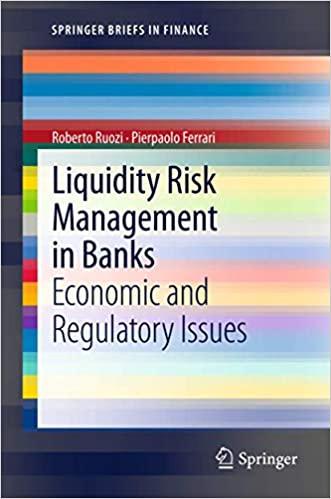
 Q5 please
Q5 please
Bank Balance Sheet Assets Reserves and cash items Securities Less than 1 year 1-2 years Greater than 2 years Residential mortgages Variable-rate Fixed-rate (30 years) Commerical loans Less than 1 year 1-2 years Greater than 2 years Physical capital Liabilities Checkable deposits Money market deposit accounts Savings deposits CDS Variable-rate Less than 1 year 1-2 years Greater than 2 years Less than 1 year 1-2 years Greater than 2 years Fed funds Borrowings Amount (Smillions) 3 437 9 15 13 31 55 10 10 5 12 6 19 8 15 10 12 9 39 Your Firm Duration (years) 0.0 0.6 1.6 5.0 0.4 5.5 0.9 1.8 6.0 0.0 1.0 0.6 1.0 0.4 0.3 1.1 2.9 0.0 0.4 1.2 2.9 Amount (Smillions) 4 5 7 9 21 17 30 22 30 25 14 9 16 12 14 10 10 14 18 12 31 Competition Duration (years) 0.0 0.3 1.2 4.0 0.9 4.4 0.6 1.4 5.4 0.0 1.0 0.5 1.0 0.6 0.5 1.8 2.2 0.0 0.7 1.8 3.8 You are in charge of examining the interest-rate risk of your bank relative to your direct competition. Interest-rate risk depends on each bank's relative position of interest-sensitive assets and liabilities. You begin the analysis by collecting the information and estimates. The table above contains all the relevant information. To prepare your presentation for the bank officers, you anticipate and answer the following questions (5 points each): 1. What are the totals for interest-rate-sensitive assets and liabilities for your firm and your competition. 2. Compute the net interest margin (NIM) for your firm for a 3% decline in interest rates. Do the same for a 3% increase in the interest rates. 3. Find the gap of your firm and your competition. 4. Using the Macaulay concept of duration, calculate the weighted duration of each asset and liability for both your firm and your competition. 5. What is the average duration for the assets and liabilities for your firm and your competition. 6. What is the duration gap for your firm and your competition. (assume that the portion of fixed-rate mortgages that will mature within 1 year is 20%, portion of checkable deposits (10%), portion of savings (20%)) Bank Balance Sheet Assets Reserves and cash items Securities Less than 1 year 1-2 years Greater than 2 years Residential mortgages Variable-rate Fixed-rate (30 years) Commerical loans Less than 1 year 1-2 years Greater than 2 years Physical capital Liabilities Checkable deposits Money market deposit accounts Savings deposits CDS Variable-rate Less than 1 year 1-2 years Greater than 2 years Less than 1 year 1-2 years Greater than 2 years Fed funds Borrowings Amount (Smillions) 3 437 9 15 13 31 55 10 10 5 12 6 19 8 15 10 12 9 39 Your Firm Duration (years) 0.0 0.6 1.6 5.0 0.4 5.5 0.9 1.8 6.0 0.0 1.0 0.6 1.0 0.4 0.3 1.1 2.9 0.0 0.4 1.2 2.9 Amount (Smillions) 4 5 7 9 21 17 30 22 30 25 14 9 16 12 14 10 10 14 18 12 31 Competition Duration (years) 0.0 0.3 1.2 4.0 0.9 4.4 0.6 1.4 5.4 0.0 1.0 0.5 1.0 0.6 0.5 1.8 2.2 0.0 0.7 1.8 3.8 You are in charge of examining the interest-rate risk of your bank relative to your direct competition. Interest-rate risk depends on each bank's relative position of interest-sensitive assets and liabilities. You begin the analysis by collecting the information and estimates. The table above contains all the relevant information. To prepare your presentation for the bank officers, you anticipate and answer the following questions (5 points each): 1. What are the totals for interest-rate-sensitive assets and liabilities for your firm and your competition. 2. Compute the net interest margin (NIM) for your firm for a 3% decline in interest rates. Do the same for a 3% increase in the interest rates. 3. Find the gap of your firm and your competition. 4. Using the Macaulay concept of duration, calculate the weighted duration of each asset and liability for both your firm and your competition. 5. What is the average duration for the assets and liabilities for your firm and your competition. 6. What is the duration gap for your firm and your competition. (assume that the portion of fixed-rate mortgages that will mature within 1 year is 20%, portion of checkable deposits (10%), portion of savings (20%))

 Q5 please
Q5 please





